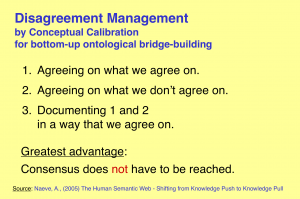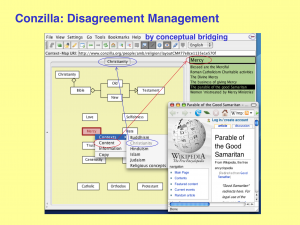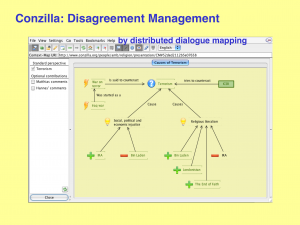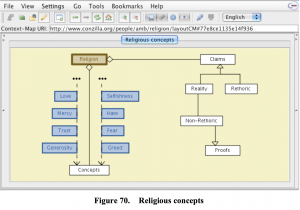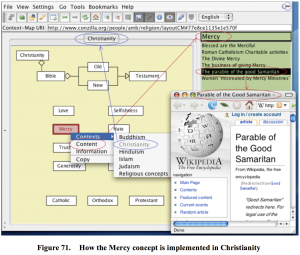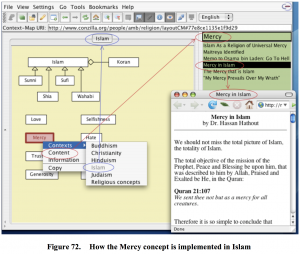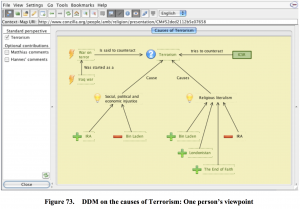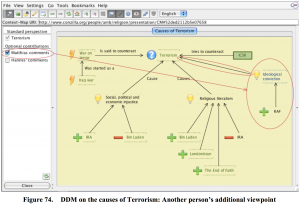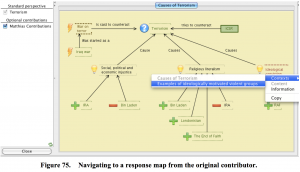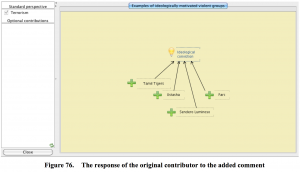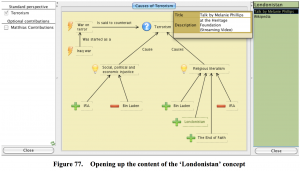This page is a sub-page of our page on Knowledge Management.
///////
The sub-pages of this page are:
• Collectigence
• Common Sense
• Climate Change
Related KMR-pages:
• TEL-Map: Possible Futures for Technology Enhanced Learning
Dynamic Roadmapping for Uncertain Times
///////
Other relevant sources of information:
• Dialogue: A Proposal, by David Bohm, Donald Factor, and Peter Garrett
• Democracy is the possibility to disagree
• The Macospol Platform Tutorial
• Naeve, A., TEL-Map Deliverable D1.1:
A Modeling Primary on Methods and Techniques for Communicative Modeling and Disagreement Management, February 2011.
////// UNDER CONSTRUCTION:
Disagreement management by conceptual calibration:
Disagreement Management 1:
Disagreement management by conceptual bridging:
Disagreement Management 2:
Disagreement Management 3:
Disagreement management by distributed dialogue mapping:
Disagreement Management 4:
Disagreement Management 5:
/////// Quoting from “A modeling primary on Communicative Modeling and Disagreement Management” (TEL-map D1.1, febr. 2011)
12.3. Disagreement Management by Conceptual Bridging
In this section we will make use of Conzilla to present a technique called Disagreement Management by Conceptual Bridging (DM-by-CB). It involves connecting concepts to contextualized content, i.e. content that varies when the concept appears in different contexts. In this way the concepts will act as “conceptual bridges” to span their semantic differences, i.e., the different meanings of the same concept in different contexts.
The example we will use to explain the DM-by-CP technique is related to comparative religion. The aim is to produce what could be termed “religious interoperability,” by which we mean the possibility of different religions to establish peaceful (semantic) coexistence, and maybe even lay the groundwork for future semantic collaboration. This example may appear somewhat far-fetched, but we believe that it is highly relevant as an attempt to counteract religious fundamentalism, which is one of the destructive forces that is threatening the future of humanity.
Figure 70 shows a simple UML-based model of religion. It shows that Religion contains Concepts and Claims. Some examples of Concepts are also shown, with the dots indicating that there are many more religious concepts not shown here.
Choosing “Content” opens up the green window to the right. It displays a list of all the content- components that have been associated with the concept of Mercy within the context of Christianity. In a realistic example, this list would represent the way the concept of Mercy is “implemented” in Christianity – i.e. the stories in Christianity that involve Mercy.
Moreover, one of the content-components – “The parable of the good Samaritan” – has been double-clicked, which brings up your ordinary web browser with a pointer to the underlying web page, which is a Wikipedia article in this case.
Choosing “Contexts” and then “Islam” leads to the situation depicted in Figure 72. Here we see the Content of the “Mercy” concept being opened up within the context of “Islam”. And the crucial issue is that this content is different, since Islam implements Mercy in a different way.
If we navigate to “Buddhism” or “Hinduism”, we will find two more different sets of content- components associated with the “Mercy” concept. In this way, each religious context implements each concept differently (= tells different stories about it), and we see how the concepts themselves act as conceptual bridges between these different implementations. This is the essence of the DM-by-CB technique.
As we will see in the next section, a crucial point is that anyone can contribute interpretations by adding content to these concepts. This is due to the Collaborilla service of Conzilla, which supports loose forms (ad-hoc) forms of online collaboration (Ebner et al., 2007). It is important to stress that these additions are not automatically incorporated into the model, but are viewable “on-demand.”
///////
12.4. Distributed Dialogue Mapping (DDM)
There are many techniques for visualizing argumentation. A good overview of these techniques as well as an account of how they developed can be found in (Kirschner et al., 2003). In this section we will concentrate on Dialogue Mapping (Conklin, 2005), and show how it can be extended and distributed on the web by making use of Conzilla.
12.4.1. Wicked Problems
The concept of wicked problems was originally proposed by Horst Rittel and M. Webber in a seminal treatise for social planning (Rittel and Webber, 1970). According to Conklin (2005), the four defining characteristics of wicked problems are:
1. The problem is not understood until after formulation of a solution.
2. Stakeholders have radically different world-views and different frames for understanding the problem.
3. Constraints and resources to solve the problem change over time.
4. The problem is never solved.
According to the overview of the history of computer-supported argument visualization by Buckingham Shum (2003):
[Wicked] problems lack a single, agreed-upon formulation or well-developed plans of action, are unique, and have no well-defined stopping rule, because there are only “better” or “worse” (rather than right or wrong) solutions. Closure is often forced by pragmatic constraints (e.g. managerial or political) rather than “rational scientific” principles. Such problems could not be solved by formal models or methodologies, classed by Rittel as the “first generation” design methodologies.
Instead, an argumentative approach to such problems was proposed (a second-generation design method). The essence of this perspective is that an open-ended, dialectic process of collaboratively defining and debating issues is a powerful way of discovering the structure of wicked problems. […]
This perspective motivated the development of Issue-Based Information Systems (IBIS) as a medium to encourage the open deliberation of issues. The key IBIS entities were Issues, Positions, and Arguments, which could be linked by relationships such as supports, objects-to, replaces, temporal- successor-of, more-general-than, and their converses. […]
To summarize, Rittel’s work established a bridge between design and argumentation. The argumentative approach to design elevated the importance of the process of understanding a problem from its minor status as a preliminary step to using first-generation design methods, to the central activity in tackling wicked design problems. Rittel and Webber (1970) hypothesized that a particularly powerful way to tackle such problems is by an “argumentative approach,” proposing IBIS as an argument mapping notation.
///////
12.4.2. Dialogue Mapping
Dialogue Mapping is an IBIS-based technique that was introduced by Jeff Conklin and which is being pursued by several institutions, notably the Knowledge Media Institute at the Open University in Milton Keynes. It offers a new approach to meetings and collaboration, in which collective intelligence is achieved through framing powerful questions and conducting a comprehensive and creative exploration of their possible answers.
Conklin (2005) presents a hands-on tutorial for practitioners of Dialogue Mapping – using the Compendium software tool developed at KMI/OU. In the first part of the book, Conklin (2005) introduces the key concepts (as stated on the back cover):
• Wicked problems: you must come up with solutions in order to understand what the problem really is … what the real issues are … and the problem definition depends on whom you ask!
• Social complexity: the number and diversity of stakeholders whose participation is essential.
• Opportunity-driven problem solving: empirical evidence says creative thinking does not follow a linear process!
• Shared understanding: overcoming fragmentation requires forging shared understanding about all aspects of the problem-solution space.
///////
12.4.3. Limitations of Classical Dialogue Mapping
From the above characteristics it is easy to see that wicked problems tend to encourage disagreement. Yet, the “shared understanding” of Conklin’s method, often requires agreement among the group of dialogue mappers: “If there is disagreement about a point, they have to stop writing until the whole group agrees on the point” (Conklin 2005, p. 31). This is due to the limitations of the Compendium tool, which does not support asynchronous and ad-hoc forms of online collaboration.
In synchronous mode, the group in fact becomes a collective mind and has to reach consensus about what issues to enter into the dialogue map they are producing. This is a weakness that can easily lead to groupthink.
According to Marcum and Smith (2008, p. 85-86):
In The Wisdom of Crowds, James Surowiecki takes the idea of collective intelligence and different perspectives much deeper. He cites dozens of studies that prove the many are smarter than the few. […] Surowiecki points out that as long as people think through ideas independently first, even the method we use to make decisions doesn’t matter much, as long as we’re tapping the collective wisdom of crowds. To put it another way, a discovery-driven process that explores what’s happening from a variety of perspectives – rather than an idea-driven process by an individual – increases the odds of making the best decision by 50 percent.
However, in a tightly connected network – such as provided by various types of social media – it is harder for people to think independently of each other. In such cases, the risk of groupthink increases.
/////// End of Quote from Buckingham Shum (2003)
12.4.4. Distributed Dialogue Mapping with Conzilla/Collaborilla
(Ebner et al., 2007, abstract):
This paper describes an approach for collaborative construction of artifacts, such as e.g. graphical maps and annotatable text documents, without requiring write-access to a common single file. Our approach is applicable to any kind of artifacts that can be divided into separate contributions, where each one is authored and stored independently, and, on request, merged into the artifact. The goal is to move collaboration issues from the files where artifacts are expressed, to an information directory. This information directory manages information around artifacts and keeps track of existing contributions to artifacts.
Our prototype of such an information directory, named Collaborilla, is designed to be a flexible service, which can be updated by anyone in a wiki-style manner. With this approach, viewing a collaboratively constructed artifact gives each viewer the control of including or excluding various contributions. Moreover, each viewer can easily choose to participate and provide a new contribution to the artifact without the other authors being aware of this. If information about this new contribution is published in the Collaborilla directory, the contribution will also be seen by others – if they choose to view it.
(Ebner et al., 2007, introduction):
Even though technology in many aspects has improved information management, collaboration is still rarely supported in practice. Even when there is technical support for collaboration, from a human perspective it is often either synchronous or turn-based. To work satisfactorily, these approaches to collaboration require careful control of concurrency [Greenberg94] or a manual/supervised merging process. We will focus on situations where collaboration is mostly asynchronous and the risk of producing inconsistencies is small.
In such situations, we argue that an important hindrance for technical support is a too tight connection between the artifact that is being developed in collaboration and the expression of it in a container. For example, when writing an article, the article is the artifact, the file where the article is located is the container, and the expression is Microsoft Office XML, Open Document Format, LaTeX, or whatever format is being used. Breaking this connection will allow multiple contributions to an artifact without requiring write access to the same container.
The central questions are, how do you:
• discover which artifacts and contributions exist?
• decide which contributions to include when viewing an artifact?
• publish artifacts and contributions to artifacts?
Part of the answer is to assign globally unique identifiers to artifacts (Berners-Lee et al. 2005), allowing them to be addressed independently of their expression in containers. This makes it possible to introduce an information directory where artifacts can be described. The focus of this paper is on the specific requirements of an information directory that keeps track of asynchronous contributions and to describe an implementation called Collaborilla (Ebner 2006).
Collaborilla has been developed for the purpose of supporting collaboration around a specific type of artifacts called Context-maps [Palmer05]. However, we believe that the design of Collaborilla is generic enough to be useful for many other artifact types, provided that their expressions and the resulting artifacts fulfill the basic requirements for collaboration.
(Ebner et al, 2007):
Much of the work done within the field of CSCW focuses on the coordination of the communication process around collaboration. For example, in [Neale04] an evaluation framework is introduced where the main variables are work-coupling, communication, and coordination. Communication and coordination refer to the human activities needed to perform the work. The work can be tightly or loosely coupled, which affects the context of the collaboration.
Furthermore, in more technical discussions, such as in [Greenberg94], the focus is on how to develop applications with concurrency-support via notification mechanisms, layers, modules etc., preferably supporting the principle of what you see is what I see (WYSIWIS). In this paper we argue that, for asynchronous collaboration with small risk of inconsistencies, collaboration is better seen as centered around the artifact than around the application, community, or stated goal. A similar argument was made in [LaMarca99] where metadata around documents is at the center of the collaboration process.
(Ebner et al, 2007):
Context-maps (Palmer and Naeve 2005) are visual representations of concepts and concept relations. The major characteristics of Context-maps are that concepts and concept-relations can be shared between maps, content can be tied to concepts and concept-relations, metadata can be attached to nearly everything, and everything is expressed in RDF. That context-maps are expressed in RDF has consequences such as allowing formalized knowledge modeling in ontologies as well as interoperability with metadata standards in general. It also makes it possible to merge independent contributions by simply joining their corresponding RDF graphs. Furthermore, a context-map is not bound to a specific modeling style. Instead it can be configured to present maps in a manner which resembles concept-maps, UML, argumentative maps etc.
We will now present an example of Distributed Dialogue Mapping. The initial perspective (created by Ambjörn) is presented in Figure 73. The issue in question is Terrorism (the blue question mark) and there are two ideas (the yellow light-bulbs) on possible causes. The first idea, Social, political and economic injustice, is strengthened (the green plus-sign) by the IRA (Irish Republican Army) and weakened (the red minus-sign) by Bin Laden. The second idea, Religious literalism is strengthened by Bin Laden, Londonistan (a book by Melanie Phillips), and The End of Faith (a book by Sam Harris) and weakened by the IRA.
In Figure 74 another perspective has been added by Matthias. By clicking on Matthias’ comments in the field to the left this perspective becomes visible in the original map. It shows that Matthias considers Ideological conviction to be another possible cause for Terrorism and that he considers the RAF (Rote Armee Fraktion).
Note that this method does not force any of the participants to take a final stance on the causes of terrorism. Each participant can express support (+) and “antiport” (-) with respect to any idea of what causes terrorism, as well as introduce new ideas on the causes – with support and ‘antiport’ for each of these.
Figure 75 shows a context switch to another map that was created by Ambjörn in response to Matthias’ comments. By copying the concept Ideological conviction into a new map, Ambjörn has added more support for the idea that Ideological conviction can be a cause for Terrorism. Ambjörn has full control of the concepts that he has added, and he can edit and change them as he pleases, but he cannot edit the concept Ideological conviction because this concept belongs to Matthias. However, he can add metadata to this concept (not shown in the figure) and express his ideas on the relevance of this concept to the issue under investigation.
Also, each contributor can support his opinion by providing content in the corresponding concepts. In Figure 77 the content window of the concept Londonistan has been opened, showing the metadata on the first content item Talk by Melanie Phillips.
/////// End of Quote from “A modeling primary on Communicative Modeling and Disagreement Management” (TEL-map D1.1, febr. 2011)
///////
Can You Hear Me Now? The Challenges and Promise of Viewpoint Diversity
If we ourselves do not embrace viewpoint diversity, and if we fail to expose students regularly to viewpoint diversity practices, we risk losing the opportunity to help students develop resilience and practice forming alliances with people whose views differ from theirs.
About the article: The posting below gives some good suggestions on to how help groups of students discuss a variety of viewpoints different from their own. It is by Richard J. Prystowsky and it appeared in Liberal Education, Winter 2021 Vol. 107, No. 1, a publication of the Association of American Colleges and Universities [ http://www.aacu.org/liberaleducation/ ].
About the author: Now retired, Richard J. Prystowsky is an emeritus professor of English and humanities and a former college senior vice president and provost. In addition to writing or giving talks on a range of topics from college writing to Holocaust studies, he has been active in promoting equity-based changes in higher education.
====
Decades ago, on the first day of a freshman composition class with readings centered on the theme of war, I asked my students to respond to the following writing prompt: “Define an enemy.” I was troubled to find that more than half of the students defined an enemy as “someone who doesn’t agree with you” (or closely related wording). Having expected to read about enemy soldiers or longtime personal conflicts, I realized that I needed to start the next class session by discussing with my students the value of exploring different viewpoints and the dangers of seeing viewpoint disagreements as personal attacks.
Sadly, in our polarized society, this critical-thinking problem continues to plague us. Rather than embracing viewpoint diversity by exploring views that deeply challenge our own, many of us often close ourselves off to different views and those who hold them. In extreme cases on college campuses, students try to silence speakers whose views they find offensive. These actions do not bring us closer to understanding and relating well to one another. In fact, they escalate rather than resolve conflicts and divide rather than unite us.
Faculty can and should create safe classroom spaces for the good-faith free exchange of ideas. During such exchanges, students are genuinely open to examining their own views critically and to hearing, reading, analyzing, writing about, discussing, and trying to understand others’ different—even personally challenging—views. As many faculty can testify, creating these active learning spaces helps students grow both intellectually and socially.
Accusations that colleges and universities stifle viewpoint diversity continue to mount. Many among the public distrust higher education. Some of our higher education colleagues claim to have lost their jobs because of their views. Scholar Steven F. Hayward, for example, wrote in the July/August 2020 issue of Commentary magazine that he “voluntarily withdrew” from his invited appointment to teach at the University of California–Berkeley’s Goldman School of Public Policy after students directed an onslaught of pressure at the dean who had hired him. Other colleagues argue that colleges and universities prepare students to be ideological purists who, after graduation, apply their learning to the detriment of society. For example, Professor John M. Ellis lamented in the Wall Street Journal in July 2020 that “universities used to be places where the major political and social issues of the day could be researched and debated” and warned that now the “campus offers not a reasoned corrective to partisan passions, but fierce, one-sided advocacy of dangerous and destructive ideas.” Lawmakers are taking notice and could respond by cutting funding for higher education.
How should we respond to such threats to the credibility (and perhaps funding) of higher education? More specifically, how can we ensure that we create allies among a diverse group of citizens who could work together to achieve a just society? If we ourselves do not embrace viewpoint diversity, and if we fail to expose students regularly to viewpoint diversity practices, we risk losing the opportunity to help students develop resilience and practice forming alliances with people whose views differ from theirs. Without this training, college graduates are ill-equipped to become civically engaged members of their communities. Working for the common good requires such alliances. Embracing viewpoint diversity is a necessary, foundational condition for achieving this end. In fact, if we persevere in this work, we might even discover that, as the following extreme example demonstrates, sometimes, unlikely allies are not so much out of reach as they are unknowingly in the making.
For years, Derek Black, the son and godson, respectively, of longtime white supremacist leaders Don Black and David Duke, was being groomed as a leader in the white nationalist movement. On his father’s Stormfront radio talk show, Derek Black articulated his vision of a white nationalist America. Charismatic and intelligent, he became a spokesperson for the movement. But then something happened.
As detailed in Eli Saslow’s Rising Out of Hatred: The Awakening of a Former White Nationalist, Black enrolled in New College of Florida, a small liberal arts college, where he secretly continued to do his radio broadcasts. But he also met and interacted with several students from groups whose members were targets of white supremacist racism. After his identity was discovered, rather than abandon him, these students ramped up their conversations with him. Patiently and respectfully, they listened to his views, countered them with their own ideas and lived experiences, and shared persuasive scholarly work with him.
To his credit, Black was open to learning about views that challenged his most deeply held convictions. In time, he began to see that his assumptions and evidence were faulty and that his radio talks profoundly harmed the kinds of people with whom he had now become friends. Now doubting his previous ideas and feeling remorse for his actions, Black abandoned his former views and, at great personal risk, left the white supremacist movement. He now speaks to audiences about the dangers of white nationalism.
Although a number of factors contributed to Black’s transformation, this change likely would not have occurred had his schoolmates not engaged him in ongoing, difficult, yet civil conversations. As educators confronting the challenges of grappling with viewpoint diversity, we might take a page out of these students’ book.
Derek Black and his schoolmates could have easily seen themselves as enemies and refused to communicate. Fortunately, they did not take that path. Thus, this case study provokes a serious question for us higher education professionals: If the heir apparent to a key faction of the white nationalist movement and the students who are targets of that movement’s racism could have such challenging and sometimes disturbing conversations, might not the rest of us, including our students, also benefit from having them?
To be sure, we need to tread carefully, since many of us have been the targets of hateful ideas and actions. But colleges and universities can encourage risk-taking in thinking and serve as safe havens for examining different viewpoints.
If we are genuinely committed to being open to others’ perspectives and the concomitant goal of securing communities’ well-being, then we need a diverse group of allies working to bridge the gaps of our often-dangerous divides. Ultimately, whatever cost we might incur to our feelings of comfort when we fully embrace viewpoint diversity, surely, as Derek Black’s story demonstrates, the cost of censoring viewpoints and silencing dialogue is far greater.
How to Guide Groups in Embracing Viewpoint Diversity
→ When possible, have participants sit in a circle in order to create a community-like setting.
→ Agree to jettison hierarchies in the room. Also agree that no one will be retaliated against for expressing a view that others do not like. One by one, everyone should commit to these agreements verbally.
→ Establish decorum rules that everyone agrees to follow (for example, no name-calling or personal attacks).
→ Ensure that everyone who wants to speak will have an opportunity to do so. (Perhaps use a “talking stick.”)
→ Especially for difficult discussions, establish common ground that unites the group (such as, “Do we all agree that we want to be engaged citizens working for the benefit of our communities?”).
→ Ask participants to avoid using overly general words or phrases such as “liberals,” “conservatives,” “the left,” or “the right.” Often, such terms are divisive and do not advance understanding or help to create alliances.
→ Remind participants to listen and speak to others as they would want others to listen and speak to them.
→ Agree to listen to others in order to understand them rather than to be ready to reply to them.
→ Before participants respond to a perspective that they find problematic, they should first summarize the perspective in a way that the person holding it would deem accurate. If they summarize it incorrectly, they should ask for clarification.
→ Commit to supporting each other, especially when people disagree. It’s normal to feel uncomfortable when hearing good-faith views that challenge one’s own assumptions.
→ Participants should not necessarily assume bad faith on the part of those whose views they find challenging.
→ At the end of each session, restate the group’s unifying common ground.
→ Inject grace. Allow for mistakes.
→ Remember: Ultimately, it’s about maintaining good relationships, establishing alliances, and strengthening the group’s health, not about adopting the same perspectives.
=========
Rick Reis
reis@stanford.edu
TOMORROW’S PROFESSOR eMAIL NEWSLETTER
Archives of all past postings can be found here:
Center for Teaching and Learning at Stanford University.
///////
